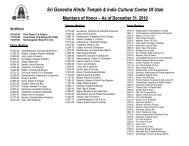Prayer to Lord Hanuman - Sri Ganesha Hindu Temple Of Utah
Prayer to Lord Hanuman - Sri Ganesha Hindu Temple Of Utah
Prayer to Lord Hanuman - Sri Ganesha Hindu Temple Of Utah
Create successful ePaper yourself
Turn your PDF publications into a flip-book with our unique Google optimized e-Paper software.
<strong>Sri</strong>nivasa Ramanujan - The man who knew infinity …<br />
<strong>Sri</strong>nivasa Ramanujan (1887 – 1920) was an Indian<br />
mathematician and au<strong>to</strong>didact who, with almost no formal<br />
training in pure mathematics, made extraordinary<br />
contributions <strong>to</strong> mathematical analysis, number theory,<br />
infinite series, and continued fractions. Ramanujan was<br />
said <strong>to</strong> be a natural genius by the English mathematician<br />
G.H. Hardy, in the same league as mathematicians like<br />
Euler and Gauss<br />
Ramanujan's introduction <strong>to</strong> formal mathematics began at<br />
age 10. He mastered advanced trigonometry by the age<br />
of 12; he even discovered theorems of his own, and re-discovered Euler's<br />
identity independently. By 17, Ramanujan had conducted his own mathematical<br />
research on Bernoulli numbers and the Euler–Mascheroni constant.<br />
Ramanujan sent samples of his theorems <strong>to</strong> academics at the University of<br />
Cambridge. G. H. Hardy, recognizing the brilliance of his work, invited<br />
Ramanujan <strong>to</strong> visit and work with him at Cambridge. Ramanujan was awarded a<br />
B.A. degree by research (this degree was later renamed PhD) in March 1916 for<br />
his work on highly composite numbers, which was published as a paper in the<br />
Journal of the London Mathematical Society.<br />
On 6 December 1917, he was elected <strong>to</strong> the London Mathematical Society. He<br />
became a Fellow of the Royal Society in 1918, becoming the second Indian <strong>to</strong> do<br />
so and he was one of the youngest Fellows in the his<strong>to</strong>ry of the Royal Society.<br />
On 13 Oc<strong>to</strong>ber 1918, he became the first Indian <strong>to</strong> be elected a Fellow of Trinity<br />
College, Cambridge "for his investigation in Elliptic functions and the Theory of<br />
Numbers."<br />
<strong>Sri</strong>nivasa died in 1920 at the young age of 32. During his short lifetime,<br />
Ramanujan independently compiled nearly 3900 results (mostly identities and<br />
equations). He stated results that were both original and highly unconventional,<br />
such as the Ramanujan prime and the Ramanujan theta function. The<br />
Ramanujan Journal, an international publication, was launched <strong>to</strong> publish work<br />
in all areas of mathematics influenced by his work.<br />
In December 2011, in recognition of his contribution <strong>to</strong> mathematics, the<br />
Government of India declared that Ramanujan's birthday (22 December)<br />
should be celebrated every year as National Mathematics Day, and also<br />
declared 2012 the National Mathematical Year.<br />
26<br />
Visit your <strong>Temple</strong>, enjoy the heritage: Open all 7 days of the week



